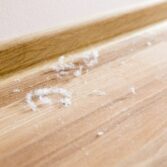Who, at least once in their life, has not questioned the possible presence of dust mites in the home? These microscopic insects, about 0.3 millimetres in size and therefore practically invisible, lurk in every corner, especially in areas where it is more difficult to identify them, such as wardrobes, shoe racks, mattresses and pillows.
Their presence should not be ignored, because it can give rise to long-lasting and irritating allergic reactions. Let’s explore this topic further.
How does an allergy to dust mites manifest? Signs and symptoms
Symptoms of a dust mite allergy can easily be confused with those of a common cold: excessively teary and itchy eyes, a runny and blocked nose, coughing and sneezing, but also a sore throat and fatigue are warning signs that, over time, may signal an allergic reaction.
These symptoms appear mainly in the morning or during the night: the mites, in fact, hide in beds and it is therefore normal to feel more discomfort after spending several hours under the covers.
Furthermore, an untreated allergy can also lead to the onset of asthma and dermatitis over time. In fact, episodes of itchy dermatitis, with skin redness and small blisters, due to the presence of mites, are not rare.
How can we fight an allergy to dust mites?
To fight an allergy to mites, it is good to adopt some good habits, which will help to keep the most irritating symptoms under control. Here are some practical tips that are easy to incorporate into your routine:
- wash your bed linen at 60°C, at least once a week;
- if possible, use a dehumidifier to keep the humidity in rooms at about 45% or lower;
- do not exceed a temperature of 22°C at home;
- use anti-mite mattresses and pillows or wrap them in a special anti-allergic cover;
- if possible, remove carpets and rugs;
- remove dust regularly using damp cloths or rags;
- use a vacuum cleaner with a HEPA filter (High Efficiency Particulate Air filter);
- clean your mattress at least once a month;
- air your house every day, opening the windows;
- remove cuddly toys or wash them often.
- replace pillows every 6 months.
If all these tips make it clear how to combat a dust mite allergy in a normal situation. If this becomes persistent, it is advisable to contact a specialist doctor for a check-up and for the evaluation of suitable therapy.
Ultrasounds to fight dust mites
When an allergy to dust mites also causes other symptoms, such as an itchy palate, tingling throat, difficulty swallowing and widespread urticaria, you could be faced with a real actual infestation.
In these cases, you can try to combine the advice in the previous paragraph with an ultrasound device. Removing the two most common species of mites, Dermatophagoides pteronyssinus and Dermatophagoides farinae, is, in fact, possible thanks to ultrasounds, which are able to limit the presence in the home of digestive enzymes and excrement of insects characterised by the allergen Der-p1.
AcarZero™ HOME is a completely non-toxic and environmentally-friendly device, which works by using ultrasound wave action, without the use of chemicals which are harmful to humans. Just place it at home, plug it into an electrical outlet and the deed is done!
However, good prevention practices should not be neglected. The combination of the two will most certainly be beneficial in improving your quality of life, thus limiting the negative effects of mites on your health.
Sources:
